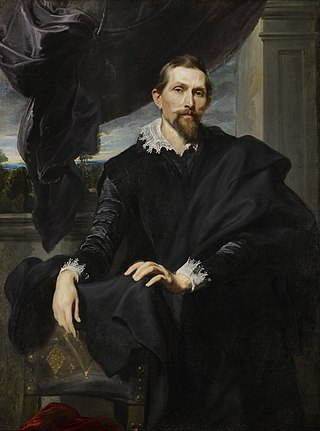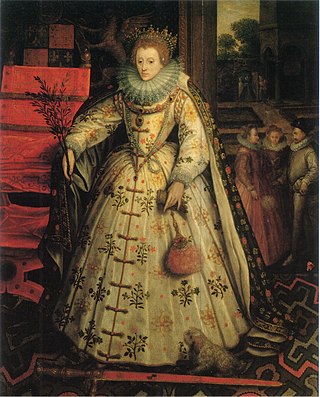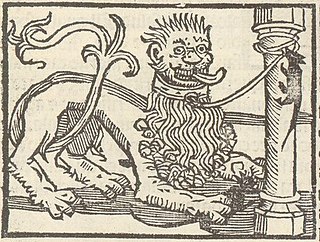
Storks are large, long-legged, long-necked wading birds with long, stout bills. They belong to the family Ciconiidae, and make up the order Ciconiiformes. Ciconiiformes previously included a number of other families, such as herons and ibises, but those families have been moved to other orders.

Aesop's Fables, or the Aesopica, is a collection of fables credited to Aesop, a slave and storyteller who lived in ancient Greece between 620 and 564 BCE. Of varied and unclear origins, the stories associated with his name have descended to modern times through a number of sources and continue to be reinterpreted in different verbal registers and in popular as well as artistic media.

Frans Snyders or Frans Snijders was a Flemish painter of animals, hunting scenes, market scenes, and still lifes. A versatile artist, his works depict all sorts of foods, utensils and tableware and wide assortment of animals. He was one of the earliest specialist animaliers and he is credited with initiating a wide variety of new still-life and animal subjects in Antwerp. His hunting scenes and still lifes engage the viewer with their dramatic and dynamic effects. He was a regular collaborator with leading Antwerp painters such as Peter Paul Rubens, Anthony van Dyck, Jacob Jordaens and Abraham Janssens.

Jan Fijt, Jan Fijt or Johannes Fijt was a Flemish Baroque painter, draughtsman and etcher. One of the leading still life and animaliers of the 17th century, he was known for his refined flower and fruit still lives, depictions of animals, garland painting and lush hunting pieces, and combinations of these subgenres, such as game, flowers and fish under a festoon of flowers. He was probably the master of the prominent Pieter Boel, who worked in a style very similar to that of Fyt.

Marcus Gheeraerts the Elder, Marc Gerard and Marcus Garret was a Flemish painter, draughtsman, print designer and etcher who was active in his native Flanders and in England. He practised in many genres, including portraits, religious paintings, landscapes and architectural themes. He designed heraldic designs and decorations for tombs. He is known for his creation of a print depicting a map of his native town Bruges and the illustrations for a Dutch-language publication recounting stories from Aesop's Fables. His attention to naturalistic detail and his practice of drawing animals from life for his prints had an important influence on European book illustration. His son Marcus the Younger became a prominent court painter at the English court.

The Frogs Who Desired a King is one of Aesop's Fables and numbered 44 in the Perry Index. Throughout its history, the story has been given a political application.

Frogs play a variety of roles in culture, appearing in folklore and fairy tales such as the Brothers Grimm story of The Frog Prince. In ancient Egypt and Mesopotamia, frogs symbolized fertility, while in classical antiquity, the Greeks and Romans associated frogs with fertility, harmony, and licentiousness.

The Lion and the Mouse is one of Aesop's Fables, numbered 150 in the Perry Index. There are also Eastern variants of the story, all of which demonstrate mutual dependence regardless of size or status. In the Renaissance the fable was provided with a sequel condemning social ambition.

Frederick Stuart Church (1842–1924) was an American artist, working mainly as an illustrator and especially known for his depiction of animals.
Foxy Fables is a short-lived animated television series produced by the leading Israeli animator Rony Oren. All the characters were made from moulded plasticine modelling clay on metal armatures, and filmed with stop motion clay animation.

The Tortoise and the Birds is a fable of probable folk origin, early versions of which are found in both India and Greece. There are also African variants. The moral lessons to be learned from these differ and depend on the context in which they are told.

Aesop is an almost certainly legendary Greek fabulist and storyteller, said to have lived c. 620–564 BCE, and credited with a number of fables now collectively known as Aesop's Fables. Although his existence remains unclear and no writings by him survive, numerous tales credited to him were gathered across the centuries and in many languages in a storytelling tradition that continues to this day. Many of the tales associated with him are characterized by anthropomorphic animal characters.

The Wolf and the Crane is a fable attributed to Aesop that has several eastern analogues. Similar stories have a lion instead of a wolf, and a stork, heron or partridge takes the place of the crane.
The Ecbasis captivi is an anonymous Latin beast fable that probably dates to the middle of the 11th century, and was likely written in the Vosges region of France. It is the oldest example of a European beast fable to survive, and the first medieval European example of anthropomorphic animals. The poem is written in hexameters with Leonine internal rhyme frequently used throughout the poem. The text survives in two manuscripts, both of which now are at the Royal Library of Belgium.

The Fox and the Stork, also known as The Fox and the Crane, is one of Aesop's fables and is first recorded in the collection of Phaedrus. It is numbered 426 in the Perry Index.

The labyrinth of Versailles was a hedge maze in the Gardens of Versailles with groups of fountains and sculptures depicting Aesop's Fables. André Le Nôtre initially planned a maze of unadorned paths in 1665, but in 1669, Charles Perrault advised Louis XIV to include thirty-nine fountains, each representing one of the fables of Aesop. Labyrinth The work was carried out between 1672 and 1677. Water jets spurting from the animals mouths were conceived to give the impression of speech between the creatures. There was a plaque with a caption and a quatrain written by the poet Isaac de Benserade next to each fountain. A detailed description of the labyrinth, its fables and sculptures is given in Perrault's Labyrinte de Versailles, illustrated with engravings by Sébastien Leclerc.

The Fox and the Lion is one of Aesop's Fables and represents a comedy of manners. It is number 10 in the Perry Index.

Jean de La Fontaine collected fables from a wide variety of sources, both Western and Eastern, and adapted them into French free verse. They were issued under the general title of Fables in several volumes from 1668 to 1694 and are considered classics of French literature. Humorous, nuanced and ironical, they were originally aimed at adults but then entered the educational system and were required learning for school children.

The Lion and the Mouse is a painting by Peter Paul Rubens and Frans Snyders, based on a scene from the fable by Aesop.


















